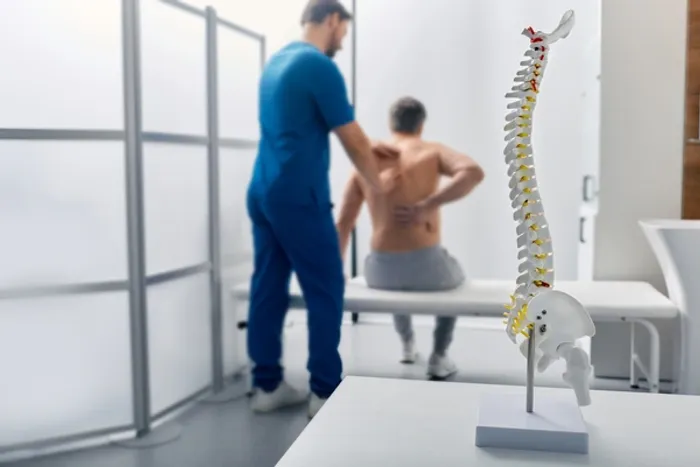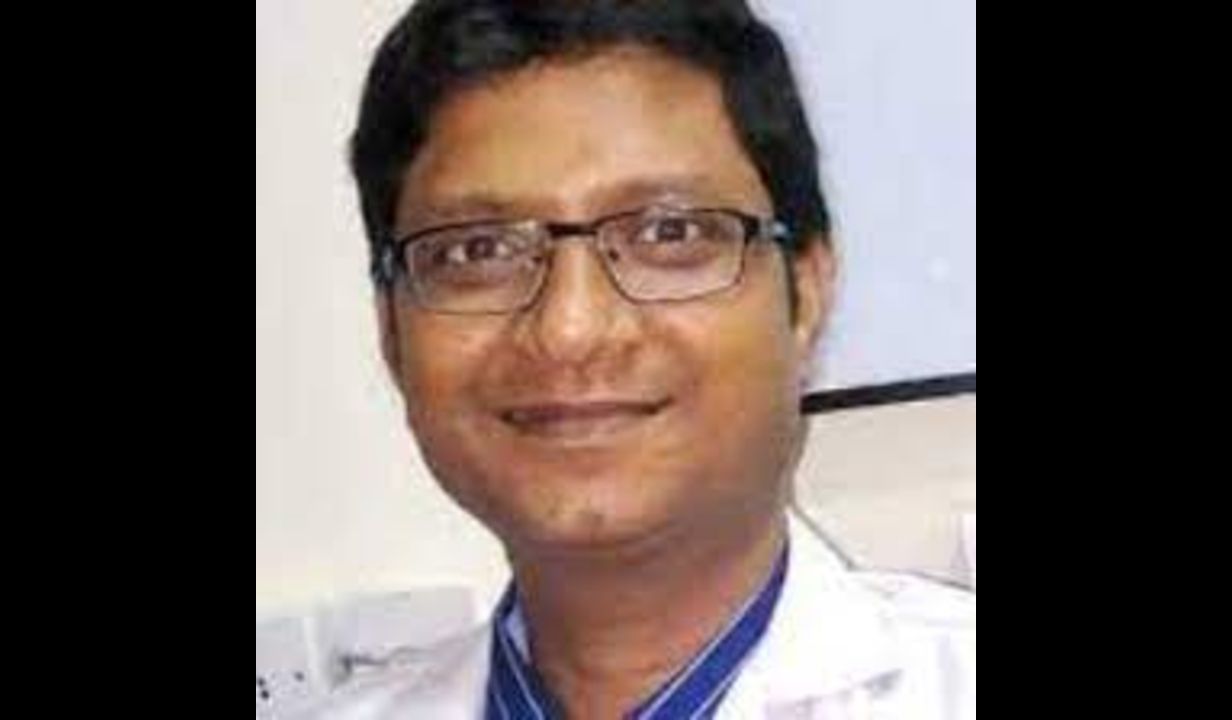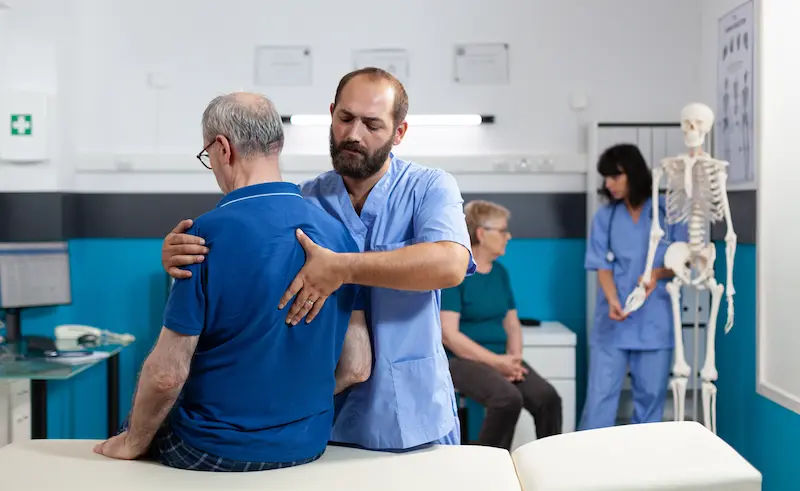A Painless Path to Recovery: How Fragile Patients Can Regain Movement After a Spinal Injury
Know about the spinal injury recovery, what it is in fragile patients, the step-by-step process for before and after surgery care, a holistic strategy for patients and more.


Introduction
Witnessing a loved one, especially one who is medically fragile, suffer a spinal injury is a terrifying experience. The immediate fear is often accompanied by a daunting question: will they ever regain a painless, mobile life? The traditional image of spinal recovery involves months of bed rest and significant discomfort. However, advancements in medical science are rewriting this narrative. This guide is designed to bring hope and clarity. We will explore how a fragile patient with a broken spine can indeed achieve remarkable milestones, often beginning to move with significantly reduced pain within the first 24 hours after modern treatment. We'll walk you through the entire journey from diagnosis and innovative treatments like kyphoplasty to post-procedure care and long-term rehabilitation, empowering you with the knowledge to support a safe and effective recovery.
Understanding the Fragile Patient and Spinal Fractures
When we talk about a fragile patient, we're not just referring to advanced age. In medical terms, this describes an individual with reduced physiological reserve, making them more vulnerable to adverse health outcomes from minor stressors, like a small fall.
Consult a Top Orthopediatric for Personalised Advice
What Does "Fragile Patient" Mean in Medical Terms?
Fragility is a distinct clinical syndrome characterized by weakness, slowness, low physical activity, and unintentional weight loss. A fragile patient has organs and systems that are already working at their limits. A simple event, such as a fall from standing height, can have catastrophic consequences because their body lacks the resilience to bounce back easily. This is why a spinal fracture in such an individual requires a specialized, gentle, and highly efficient approach to treatment to avoid further decline.
Types of Spinal Fractures Common in Fragile Individuals
The most common spinal injury in fragile patients is a vertebral compression fracture (VCF). This occurs when one of the block-like bones in the spine (vertebrae) collapses due to weakened bone, most often from osteoporosis. Unlike a traumatic "broken back" seen in accidents, a VCF can sometimes happen from something as simple as coughing or bending over. The primary symptom is often sudden, severe back pain, but it can sometimes be mistaken for general arthritis. Accurate diagnosis is the first critical step toward a painless recovery.
The Reality of "Painless" and "24-Hour" Recovery
It's crucial to manage expectations. "Painless" does not mean the patient feels nothing. Instead, it signifies a dramatic reduction from the acute, debilitating pain to a manageable level of discomfort. The "within 24 hours" timeline refers to the mobilization potential after specific, minimally invasive procedures.
Modern Minimally Invasive Procedures: The Game Changer
For eligible patients, procedures like vertebroplasty and kyphoplasty have revolutionized care. These are not major open surgeries. They involve small incisions, are often performed under local anaesthesia or mild sedation (safer for fragile patients), and aim to stabilise the fracture from the inside.
Vertebroplasty: Stabilising the Spine with Cement
In this procedure, medical-grade bone cement is injected directly into the fractured vertebra. This cement hardens quickly, stabilizing the bone and preventing the tiny nerve-irritating movements that cause intense pain. Think of it like filling a crack in a wall with a strong filler. Many patients report pain relief almost immediately after the procedure.
Kyphoplasty: Restoring Height and Alleviating Pain
Kyphoplasty is a slight advancement. Before injecting the cement, a small balloon is inserted and gently inflated inside the fractured vertebra. This helps restore the bone's original height and corrects spinal deformity. It also creates a cavity for the cement, allowing for a more controlled injection. This is often the preferred non-surgical treatment for spinal compression fracture as it addresses both pain and spinal alignment.
What to Realistically Expect in the First 24 Hours
After a successful kyphoplasty or vertebroplasty, the patient is typically moved to a recovery room. Within a few hours, under careful supervision, a physical therapist will help them sit up on the edge of the bed. The profound difference is that the movement which was once excruciating is now tolerable. By the 24-hour mark, many patients are able to stand and take a few steps with assistance. This early mobilization is critical—it prevents the complications of prolonged bed rest (like pneumonia blood clots) that are particularly dangerous for fragile patients.
A Step-by-Step Guide to Pre- and Post-Procedure Care
The procedure itself is only one part of the journey. Comprehensive care before and after is what ensures a successful and sustained painless outcome.
Pre-Procedure: Diagnosis and Preparation for a Smooth Experience
An accurate diagnosis is made using imaging like an X-ray or MRI to confirm a spinal compression fracture. The medical team will assess the patient's overall health to ensure they are a candidate for the procedure. If your loved one's condition is complex, consulting a specialist is essential. Platforms like Apollo24|7 can connect you with expert neurosurgeons or orthopedists for an online consultation to discuss the best way forward.
The Critical First 24 Hours: Mobilisation and Pain Management
The primary goal immediately after the procedure is controlled mobilization. The clinical team will manage any residual discomfort with appropriate medications. The role of the family and caregivers is to provide encouragement and reassurance. Witnessing a loved one stand and walk again so soon after a severe injury is a powerful moment that boosts morale for everyone involved.
Long-Term Rehabilitation for Sustained Pain-Free Movement
Leaving the hospital is just the beginning. Long-term rehabilitation after kyphoplasty is non-negotiable. A physical therapist will design a program focusing on:
- * Strengthening: Building core muscles to support the spine.
- * Balance Training: Reducing the risk of future falls.
- * Posture Education: Learning safe ways to move, bend, and lift.
This commitment to therapy is what transforms short-term pain relief into a lasting, painless active life.
Beyond the Procedure: Holistic Strategies for a Fragile Spine
True recovery extends beyond the fracture site. It involves building a foundation of health that supports the entire skeletal system.
Nutritional Support for Bone Health
A diet rich in calcium and Vitamin D is fundamental. Sometimes, diet alone isn't enough. A doctor may recommend supplements and might suggest a bone density test to monitor progress. For convenience, services like Apollo24|7 offer home collection for essential tests like Vitamin D levels, making it easier for fragile patients to stay on top of their health.
Safe Movement and Fall Prevention Techniques
Preventing a second fracture is paramount. This involves making the home environment safer by removing tripping hazards, installing grab bars in bathrooms, and ensuring adequate lighting. Encouraging the use of prescribed mobility aids, like a walker, can provide stability and confidence.
Conclusion
A diagnosis of a broken spine in a fragile patient is undoubtedly serious, but it is no longer a sentence to a life of immobility and pain. The landscape of treatment has been transformed by techniques that are as gentle as they are effective. By understanding the options, from kyphoplasty to targeted rehabilitation, families can move from a place of fear to one of active hope. The goal is not just to heal a fracture but to restore a person's independence and quality of life. If you suspect a loved one has suffered a spinal injury, seeking immediate specialized medical attention is the most important step. With the right care, the journey back to painless movement can begin astonishingly fast. If you need guidance on the next steps, consider consulting a specialist through Apollo24|7 to evaluate the condition and discuss the best possible treatment plan.
Consult a Top Orthopediatric for Personalised Advice
Consult a Top Orthopediatric for Personalised Advice

Dr. Sunil Rajan
Orthopaedician
20 Years • MBBS, MS(Ortho)
Indore
Apollo Hospitals Vijay Nagar, Indore
(25+ Patients)

Dr. Avinash Benjamin
Orthopaedician
13 Years • MBBS, MS
Indore
Apollo Hospitals Vijay Nagar, Indore
(25+ Patients)

Dr. Rahul Puri
Orthopaedician
15 Years • MBBS, MS
Bengaluru
Apollo Hospitals Jayanagar, Bengaluru
(50+ Patients)

Dr. M N Amarnath
Orthopaedician
10 Years • MBBS,MS(Ortho, NIMS,Hyd) Fellowship in Shoulder and Elbow Surgery(Seoul, S.Korea) Fellowship in Arthroscopy and Sports Injury Fellowship in Joint Replacement Consultant Orthopaedic Surgeon
Hyderguda
Apollo Hospitals Hyderguda, Hyderguda
(25+ Patients)

Dr. Kumar Satyakam
Orthopaedician
10 Years • MBBS, MS (Ortho), IPGME&R, WBUHS
Kolkata
Apollo Multispeciality Hospitals , Kolkata, Kolkata
(50+ Patients)
Consult a Top Orthopediatric for Personalised Advice

Dr. Sunil Rajan
Orthopaedician
20 Years • MBBS, MS(Ortho)
Indore
Apollo Hospitals Vijay Nagar, Indore
(25+ Patients)

Dr. Avinash Benjamin
Orthopaedician
13 Years • MBBS, MS
Indore
Apollo Hospitals Vijay Nagar, Indore
(25+ Patients)

Dr. Rahul Puri
Orthopaedician
15 Years • MBBS, MS
Bengaluru
Apollo Hospitals Jayanagar, Bengaluru
(50+ Patients)

Dr. M N Amarnath
Orthopaedician
10 Years • MBBS,MS(Ortho, NIMS,Hyd) Fellowship in Shoulder and Elbow Surgery(Seoul, S.Korea) Fellowship in Arthroscopy and Sports Injury Fellowship in Joint Replacement Consultant Orthopaedic Surgeon
Hyderguda
Apollo Hospitals Hyderguda, Hyderguda
(25+ Patients)

Dr. Kumar Satyakam
Orthopaedician
10 Years • MBBS, MS (Ortho), IPGME&R, WBUHS
Kolkata
Apollo Multispeciality Hospitals , Kolkata, Kolkata
(50+ Patients)
More articles from Spine Injury
Frequently Asked Questions
What are the first signs of a spinal fracture in a fragile elderly person?
The most common sign is a sudden onset of severe back pain, often after a minor fall or even without a clear injury. The pain may worsen when standing or walking and feel better when lying down. Sometimes, there is a visible curvature (hunching) of the spine.
Is vertebroplasty/kyphoplasty safe for someone with multiple health issues?
These procedures are generally considered safer than open surgery for fragile patients because they are minimally invasive. However, a thorough pre-procedure evaluation by an anesthesiologist and surgeon is essential to assess individual risks and ensure the patient is a suitable candidate.
How long does the pain relief from these procedures last?
For the vast majority of patients, the pain relief achieved from vertebroplasty or kyphoplasty is permanent for the treated fracture. The cement stabilises the bone indefinitely. Long-term success also depends on following a rehabilitation plan to strengthen the surrounding muscles and prevent new fractures.
What happens if a fragile patient is not a candidate for these procedures?
Non-surgical management is an option. This includes rest, pain medication, bracing, and very gentle physical therapy. However, this approach often involves a longer period of pain and immobility, which carries its own risks for fragile individuals. The decision is made collaboratively between the family and the medical team.
Can a person get another spinal fracture after a successful kyphoplasty?
Yes. While kyphoplasty fixes the specific fractured vertebra, the underlying osteoporosis or bone weakness remains. Therefore, it is critical to continue with medical treatment for osteoporosis and fall prevention strategies to protect other vertebrae.


